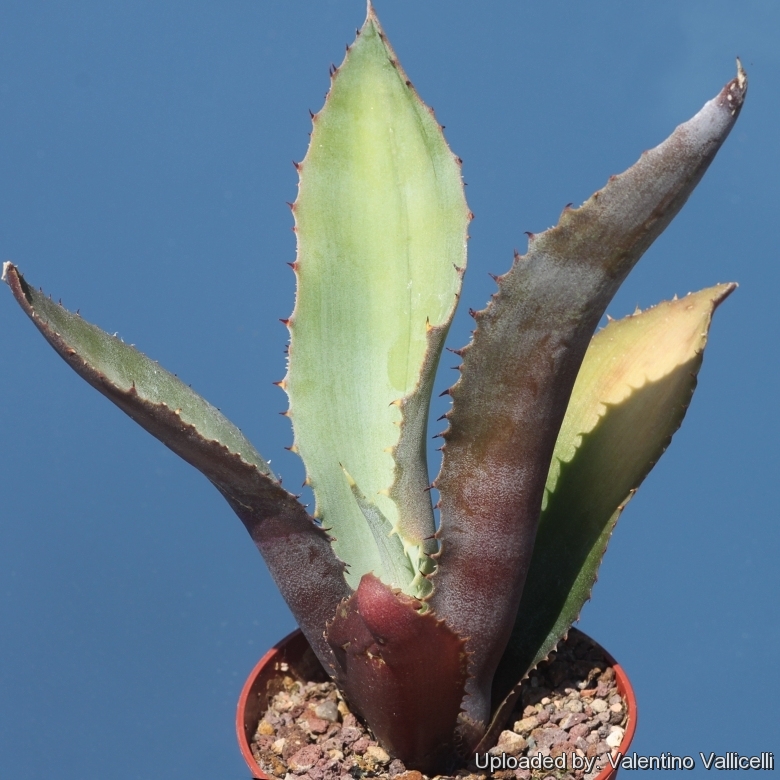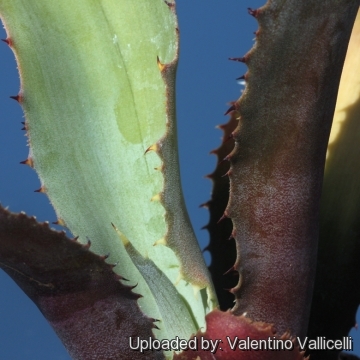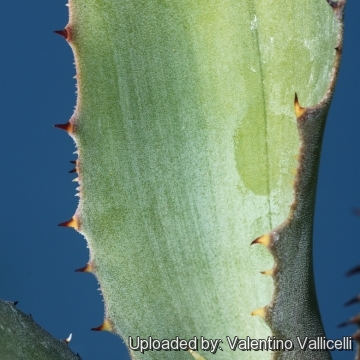
Agave marmorata Photo by: Valentino Vallicelli
Origin and Habitat: Oaxaca, Mexico
Synonyms:
See all synonyms of Agave marmorata
back
Accepted name in llifle Database:Agave marmorata Roezl ex OrtgiesGartenflora 23: 76 (1874). et in Belg. Hortic. (1883) 238.Synonymy: 2
Accepted name in llifle Database:Agave marmorata f. brachyphylla hort.
Cultivars
(1):
back
Common Names include:
ENGLISH: Marbled Agave
SPANISH (Español): Huiscole, Pisomel
Description: Agave marmorataSN|589]]SN|519]] is an unusual, mid-sized species generally non-suckering with large, broad leaves. It is named “marmorata” (marbled) for the greyish marble-like hue and transverse zones that bar sometimes the leaves especially on specimens grown in full sun.
Stem: stemless or short stemmed.
Rosettes: 1,2-1,3 m wide and up to 2 m in diameter, large with about 30-50 leaves, often prostrate, openly spreading, more or less irregular in shape with contorted leaves flattened on the ground.
Leaves: 100-135 cm long 20-30 cm wide, soft-fleshy, convoluted, recurved from the centre, broadly lanceoate, frequently undulate, thick at base, flat above, convex below, generally characteristically sandpaper-surfaced, dusky green to slightly glaucous, often zonate (distinctly striped) in pale blue and greyish green, but quite variable in differed populations and clones. The shape and patterns of leaves also depends on cultivation conditions. The back of leaves are often purple in young specimens. Margins deeply serrated, teeth more or less numerous, mostly 6-12 mm long, 2-5 cm apart, irregularly arranged on nipples, flattened, mostly straight, castaneous to dark brown, interstitial teeth few or none; apical spine usually short conic, 1.5-3 cm long and horny.
Inflorescence: The inflorescence is a 5-6.5 m tall panicle with stout peduncle and
20-25 large diffuse decompound umbels in upper half of stalk; usually with no bulbils.
Flowers: Small yellow, 40-48 mm long; ovary 20-25 mm long, light green, cylindric, the neck unconstricted and scarcely grooved; tube 5-6 mm deep, 12 mm wide, shallowly funnelfonn, grooved, the sinuses soon spreading; tepals equal, 14- 16 mm long, 4 mm broad, linear, fleshy, erect, involute, the apex galeate, dark colored; filaments 34-37 mm long, inserted in orifice of tube or near base of tube, slender, yellow; anthers 18 mm long yellow.
Fruit: Capsules oblong, 4 it 1.6-1.8 cm slender stipitate, short-beaked, thin-walled
Remarks: Several other agaves species have very contrasting areas: Agave colorata, Agave murpheyi, Agave sobriaSN|505]]SN|22226]], and some selected clones of Agave zebraSN|519]]SN|589]] and Agave americanaSN|162]]SN|162]].
Agave marmorataSN|589]]SN|519]] belongs to the Marmoratae tribe along with Agave gypsophilaSN|22226]]SN|505]], Agave nayaritensis, Agave valenciana and Agave zebraSN|519]]SN|589]].
Subspecies, varieties, forms and cultivars of plants belonging to the Agave marmorata group
 Agave marmorata Roezl ex Ortgies: is a mid-sized species with large, broad greyish leaves marbled with transverse zones that bar sometimes the leaves especially on specimens grown in full sun.
Agave marmorata Roezl ex Ortgies: is a mid-sized species with large, broad greyish leaves marbled with transverse zones that bar sometimes the leaves especially on specimens grown in full sun.- Agave marmorata f. brachyphylla hort.: is a monstrous form with individual leaves not longer than wide.
 Agave marmorata cv. Papilio Platanioïdes: is an odd dwarf cultivars with round leaves ending in a thin “tail” looking like a green swallowtail butterfly (Papilio sp.).
Agave marmorata cv. Papilio Platanioïdes: is an odd dwarf cultivars with round leaves ending in a thin “tail” looking like a green swallowtail butterfly (Papilio sp.).
 Agave marmorata Photo by: Valentino Vallicelli
Agave marmorata Photo by: Valentino Vallicelli Agave marmorata Photo by: Valentino Vallicelli
Agave marmorata Photo by: Valentino Vallicelli Agave marmorata Photo by: Valentino Vallicelli
Agave marmorata Photo by: Valentino VallicelliSend a photo of this plant.The gallery now contains thousands of pictures, however it is possible to do even more. We are, of course, seeking photos of species not yet shown in the gallery but not only that, we are also looking for better pictures than those already present.
Read More... Cultivation and Propagation: It is a stunning specimen plant for containers or a well drained spot in the garden. It tend to be slow grower, but worth the effort. Grow it in porous soil with adequate drainage. It do well in full sun or a lightly shaded area. Water thoroughly when soil is dry to the touch. In winter watering this plant can be done once every 1-2 months, there is no need to mist the leaves.
It holds up well in drought situations and can take light freezes.
Propagation: Relatively easy to propagate by seeds or by suckers (if available) Remove the basal suckers in spring or summer and let the cuttings dry for a few days before inserting in compost, only problem is the logistics of getting to the suckers - very sharp spines and suckers usually right up against, or underneath the mother plant.
Uses: These striking plants are wonderful when used for accent or simply to provide some all year round foliage colour and often used in a pot as a patio plant, they make an eye-catching statement and along with other evergreen plants in pots, can be moved around to change the scenery or position to give more shelter.













